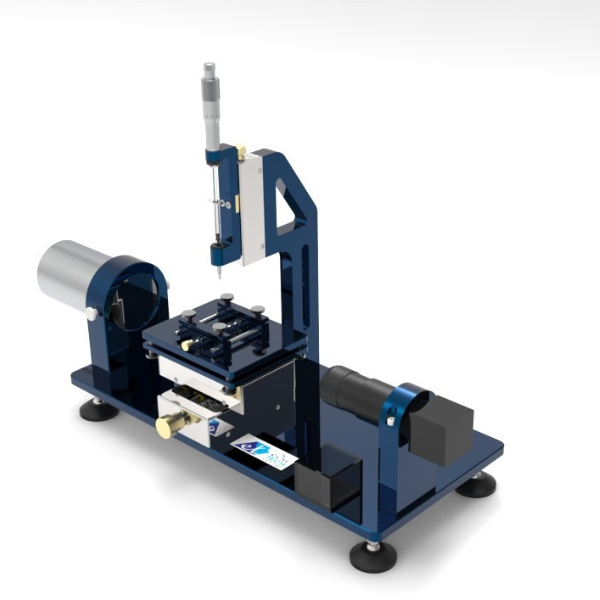SM-113 | CONTACT ANGLE GONIOMETER
- The equipment adopts the principle of optical imaging
- Light source adopts dense LED cold light design, uniform light-emitting, image cleaning, and long life
- The injection unit adopts micro manual knob-type liquid injection, with stable drip and high precision
- The sample table adopts a 3D manual fine adjustment platform, flexible operation, and accurate positioning; the sample table can be customized according to the actual sample size
- The main machine adopts the modular design concept of a high-strength aluminum alloy structure
- Industrial-grade dense adjustable LED cold light source system (life of more than 25000 hr) is adopted to ensure clearer imaging and avoid evaporation of small droplets caused by extra heat
- High-performance industrial movement, industrial-grade continuous variable-magnification microscope, to ensure the authenticity of the image, to obtain optimal imaging results
- L x W x H: 550 x 196 x 485 mm Approx.
- Weight: 11 kg Approx.
Description
Technical Specification
Media
Contact Angle refers to the tangent line of the gas-liquid interface at the intersection point of gas, liquid, and solid. This tangent line has an Angle between the liquid and the solid-liquid boundary. The measurement of Contact Angle is the main method of surface performance detection nowadays.
Standard contact Angle measurement instrument is to use the principle of optical imaging, image contour analysis way to measure the surface contact Angle, wettability, interfacial tension of the table, and surface energy, such as performance, equipment cost-effective, comprehensive functions, and can meet the demand of conventional measurement has been widely used in many colleges and universities institutes and enterprises.
As shown in the figure, the contact Angle measuring instrument is mainly composed of five parts:
- light source
- injection unit
- sample table
- acquisition system
- analysis software
Contact Angle professional measurement method
- Sessile drop
- Lamella method
- Captive bubble method
- Wetted fiber
- Sessle fiber drop
Software
The acquisition system adopts the black and white imported CCD camera, which is stable to shoot, clear and reliable images. The lens is equipped with the industrial-grade imported configuration, with the magnification adjustable from 0.7 to 4.5 times, and the imaging is free from deformation. The analysis software has powerful functions, has an automatic fitting ability, has the most advanced fitting method in the world, and meets the precise fitting of various droplet forms.- Dynamic shooting and video quick test data can continuously record the change of test contact Angle, and then the software can automatically batch-fit.
- The software automatically generates reports
Standards
- GB/T 24368-2009(detection of hydrophobic pollutants on glass surface);
- SY/ t5153-2007 (reservoir rock wettability measurement method);
- ASTM D 724-99 (2003) (test method for wettability of paper surfaces);
- ASTM d5946-2004 (measurement of the contact Angle between plastic film and water);
- ISO15989 (measurement of water contact Angle of plastic film and thin plate corona-treated film);
Light Source System
- Light Source: Dense LED can adjust blue tone industrial grade cold light source
- Lifelong: The surface life is more than 25,000 hours
Injection Unit
- Injector: Dedicated precision syringe capacity 1000 μL
- Drip: Manually rotatory injection, drip precision can be achieved 0.2 μL
- Injection Unit Movement: Up down 100 mm; Left right: 100 mm
Sample Station Installation
- Worktable Size: 120mm × 150mm minimum
- Maximum sample size: 10inch
Acquisition System
- CCD: high-speed industrial chip with 25 frames /S and 130W pixels
- Lens: 0.7-4.5 times HD industrial-grade continuous variable magnification microscope
- Acquisition System Adjustment: Before and after 60mm, the view angle is adjustable (smooth inspect, look down, 360o rotating angle of view, etc.)
- Power: 220 V/60 HZ
Any questions? We are happy to help...
+49 40 670 854 - 0
sales@gunt.de
Newsletter
About Us
EduTech Lahore excels in designing and supplying cutting-edge equipment for Engineering Education in Mechanical, Polymer Chemical, Civil and Control Engineering. Focused on meeting the demand for quality education, we offer cost-effective solutions for the latest teaching equipment.
Contact Info
Head Office (Asia)
EduTech
Lahore
Regional Partner Office (UK)
Sales Partner (Middle East) GCC International FZC
Leave a Message
WhatsApp us

